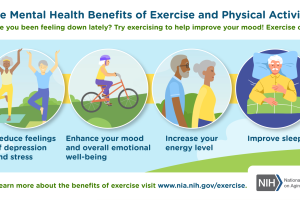The Impact of Exercise on Mental Well-being

Brief Overview
Mental well-being is a cornerstone of overall health, influencing how we think, feel, and interact with others. It plays a crucial role in daily functioning, productivity, and relationships. Just like physical health needs attention, so does our mental state. Consider this: those who prioritize mental wellness often report higher levels of happiness and life satisfaction.
- The Impact of Exercise on Mental Well-being
- Brief Overview
- Importance of Mental Well-being
- The Connection Between Exercise and Mental Health
- Scientific Studies
- Neurochemical Effects
- Benefits of Exercise on Mental Well-being
- Reduced Stress Levels
- Improved Mood
- Physical Activity and Anxiety
- Effects on Anxiety Symptoms
- Recommended Exercises
- Exercise as a Tool for Depression Management
- Role in Depression Treatment
- Endorphins and Depression
- Impact of Regular Exercise on Cognitive Function
- Brain Health Benefits
- Prevention of Cognitive Decline
- Exercise in Relation to Sleep and Mental Well-being
- Sleep Quality Improvement
- Circadian Rhythm Regulation
- Exercise and Self-Esteem
- Positive Body Image
- Confidence Boost
- Social Benefits of Exercising for Mental Well-being
- Community Support
- Group Fitness Activities
- Creating a Balanced Exercise Routine for Mental Health
- Incorporating Different Types of Exercise
- Setting Realistic Goals
- Overcoming Barriers to Exercise for Better Mental Well-being
- Time Constraints
- Motivation Challenges
- Seeking Professional Guidance for Exercise and Mental Health
- Consulting with a Healthcare Provider
- Working with a Personal Trainer
- XIII. Mindful Movement Practices for Mental Well-being
- Yoga and Meditation
- Tai Chi and Qigong
- XIV. Incorporating Exercise into Daily Life for Improved Mental Health
- Walking and Active Commuting
- Home Workouts and Bodyweight Exercises
- XV. Conclusion and Recommendations
- Summary of Key Points
- Practical Tips for Harnessing Exercise for Mental Well-being
Importance of Mental Well-being
Why is mental well-being so important? Here are a few compelling reasons:
- Quality of Life: Positive mental health enhances the overall quality of life.
- Physical Health: There is a strong connection between mental and physical health; stress can lead to various physical ailments.
- Resilience: Good mental well-being builds resilience against stress and setbacks.
By understanding and emphasizing the importance of mental well-being, individuals can take proactive steps to improve their overall quality of life.
The Connection Between Exercise and Mental Health
Scientific Studies
Numerous scientific studies underline the powerful link between exercise and mental health. Research indicates that regular physical activity significantly reduces symptoms of anxiety and depression. For instance:
- A meta-analysis published in the Journal of Clinical Psychiatry found that participants engaging in regular exercise experienced a 20-30% reduction in depressive symptoms.
- Another study in Psychosomatic Medicine showed that even moderate physical activity, like walking, positively impacts mental health.
These findings suggest that exercise isn’t just beneficial for the body—it can transform the mind, too.
Neurochemical Effects
Ever wondered how a simple jog can leave you feeling euphoric? This can be attributed to the neurochemical effects triggered by exercise. When you engage in physical activity, your brain releases a cocktail of chemicals, including:
- Endorphins: Known as the body’s natural painkillers; they create feelings of happiness.
- Serotonin: This mood regulator helps to alleviate feelings of anxiety and depression.
- Dopamine: Often referred to as the “feel-good” neurotransmitter, it enhances motivation and pleasure.
These neurochemical changes explain why many people feel an immediate sense of relief and positivity post-exercise—a perfect example of how body and mind resonate with one another.
Benefits of Exercise on Mental Well-being
Reduced Stress Levels
Building on the neurochemical effects we just discussed, exercise plays a vital role in reducing stress levels. When engaging in physical activities, the body lowers the production of stress hormones like cortisol, which can create a sense of calm. Here’s how exercise helps with stress:
- Distraction: Focusing on a workout can divert attention from daily pressures.
- Routine: A regular exercise schedule can establish a sense of control and stability.
- Social Interaction: Group activities foster connections, providing emotional support.
Improved Mood
In addition to lowering stress, exercise is a potent mood booster. Many individuals report feeling more energized and positive after a workout. Consider these benefits:
- Endorphin Release: As mentioned, exercise triggers the release of endorphins, enhancing feelings of joy.
- Increased Confidence: Achieving fitness goals boosts self-esteem and body image.
- Sense of Accomplishment: Completing a workout can deliver immediate satisfaction.
Engaging in regular physical activity not only improves mental resilience but also cultivates a happier, more fulfilled life.
Physical Activity and Anxiety
Effects on Anxiety Symptoms
Transitioning from mood improvement, it’s important to explore how physical activity specifically affects anxiety symptoms. Regular exercise provides a natural outlet for stress, reducing tension and fostering a sense of stability. Here’s what the research has shown:
- Reduction in Anxiety Levels: Engaging in consistent exercise can decrease generalized anxiety disorder symptoms significantly.
- Enhanced Coping Abilities: Physical activity helps individuals develop coping strategies, making it easier to manage anxiety in daily life.
Many people find that a brisk walk or a workout can calmand restore their mental clarity in moments of anxiety.
Recommended Exercises
If you’re looking for effective ways to combat anxiety through physical activity, here are some recommended exercises:
- Aerobic Activities: Running, cycling, or swimming can elevate heart rates and release feel-good endorphins.
- Yoga: This practice promotes relaxation and mindfulness, which can directly reduce anxiety.
- Strength Training: Lifting weights helps in building resilience, both physically and mentally.
- Team Sports: These activities not only offer physical benefits but also create social connections that ease feelings of isolation.
Incorporating these exercises into a daily routine can significantly help in alleviating anxiety, leading to a more relaxed and contented life.
Exercise as a Tool for Depression Management
Role in Depression Treatment
Following the exploration of anxiety, it’s essential to highlight how exercise serves as a powerful tool for managing depression. Many mental health professionals recommend physical activity as a complementary treatment alongside therapy and medication. Here’s how exercise contributes to depression management:
- Improved Energy Levels: Regular physical activity can combat fatigue, making daily tasks feel more achievable.
- Structure and Routine: Committing to a workout schedule provides a sense of purpose and accomplishment.
- Social Engagement: Being active can lead to social interactions, reducing feelings of isolation commonly associated with depression.
It’s evident that incorporating exercise into one’s lifestyle can be transformative.
Endorphins and Depression
A significant reason why exercise aids in depression management is the release of endorphins. These natural chemicals are often referred to as “feel-good” hormones, and they play a crucial role in mood enhancement. Consider these effects of endorphins:
- Pain Relief: Endorphins can alleviate physical pain, leading to overall improved well-being.
- Mood Elevation: The surge of endorphins during and after exercise creates a euphoric feeling, helping to counteract depressive symptoms.
- Enhanced Resilience: As endorphins elevate mood, individuals become more resilient to daily stressors.
Incorporating even a small amount of exercise into one’s daily routine can significantly uplift mood and provide hope in managing depression.
Impact of Regular Exercise on Cognitive Function
Brain Health Benefits
Transitioning from the psychological benefits of exercise, it’s crucial to focus on its impact on cognitive function. Regular physical activity isn’t just good for the body; it’s vital for brain health as well. Engaging in exercise can lead to:
- Enhanced Memory: Physical activity encourages the growth of new brain cells, boosting memory retention.
- Increased Focus: Exercise improves blood flow to the brain, sharpening focus and concentration.
- Neurotransmitter Balance: It helps regulate neurotransmitters, which play a significant role in mood and cognition.
With these benefits, it becomes clear that a fit body contributes to a sharper mind.
Prevention of Cognitive Decline
Additionally, regular exercise is linked to the prevention of cognitive decline as one ages. Studies suggest that active individuals are less likely to experience degenerative brain diseases. Here’s how exercise contributes to this prevention:
- Reduced Inflammation: Exercise combats inflammation, a key factor in various cognitive disorders.
- Improved Blood Flow: Better circulation nourishes the brain, ensuring it functions optimally over time.
- Cognitive Reserve: Regular activity builds cognitive resilience, enhancing the brain’s ability to cope with age-related changes.
By maintaining an active lifestyle, individuals can enjoy enhanced cognitive health and stave off the effects of aging on the mind.
Exercise in Relation to Sleep and Mental Well-being
Sleep Quality Improvement
Building on cognitive benefits, let’s delve into the relationship between exercise, sleep, and overall mental well-being. Regular physical activity is a game-changer for sleep quality. Many people find that engaging in regular exercise helps them fall asleep faster and enjoy deeper sleep cycles. Here are some ways exercise enhances sleep:
- Reduced Insomnia Symptoms: Moderate to vigorous exercise can reduce insomnia severity by up to 55%.
- Relaxation: Physical activity promotes relaxation and helps to alleviate the tension that often hinders sleep.
- Energy Expenditure: The body’s need for recovery after exercise encourages deeper sleep patterns.
Incorporating exercise into your daily routine can be an effective way to boost both sleep and mental health.
Circadian Rhythm Regulation
In addition to improving sleep quality, exercise plays a vital role in regulating circadian rhythms. Our biological clock influences when we feel awake and tired, and physical activity helps keep this cycle in check. Key points about circadian rhythm regulation through exercise include:
- Morning Workouts: Exercising early in the day can help reinforce the body’s natural wakefulness.
- Evening Relaxation: Gentle activities like yoga in the evening can signal the body to wind down, promoting restful sleep.
- Consistency is Key: Regular physical activity at consistent times helps stabilize your circadian rhythm, resulting in better sleep and improved overall mental health.
By leveraging the relationship between exercise and sleep, individuals can achieve enhanced mental well-being and resilience against daily stressors.
Exercise and Self-Esteem
Positive Body Image
Shifting our focus from sleep, let’s examine how exercise influences self-esteem, particularly through the lens of body image. Engaging in regular physical activity can lead to a more positive perception of one’s body. This transformation is not just physical; it also cultivates a healthier mindset. Here’s how exercise fosters a positive body image:
- Improved Physical Fitness: As you work out and see progress, whether it’s increased strength or endurance, it can enhance how you feel about your body.
- Enhanced Physical Appearance: Regular activity can lead to weight loss and toned muscles, positively impacting self-image.
- Mind-Body Connection: Activities like yoga promote an appreciation for your body’s capabilities, improving self-acceptance.
When people learn to appreciate their bodies, their self-esteem often flourishes.
Confidence Boost
Not only does exercise elevate body image, it also provides a significant confidence boost. Many people report feeling more empowered and capable when they engage in regular physical activity. Consider these aspects of how exercise builds confidence:
- Goal Achievement: Setting and reaching fitness goals creates a sense of accomplishment, reinforcing self-worth.
- Social Interactions: Whether in a gym class or a team sport, exercising with others fosters camaraderie, which can enhance feelings of belonging.
- Stress Relief: By reducing anxiety through exercise, individuals can approach challenges with a more confident mindset.
Overall, the journey towards fitness often translates to increased confidence, allowing individuals to navigate life’s hurdles more effectively.
Social Benefits of Exercising for Mental Well-being
Community Support
Transitioning from the confidence gained through individual exercise, it’s essential to explore the social benefits of exercising, particularly the role of community support. Engaging in physical activities often opens the door to a network of individuals who share similar health goals and interests. Here’s how community support makes a difference:
- Shared Experiences: Connecting with others who face similar challenges fosters camaraderie and reduces feelings of isolation.
- Encouragement and Motivation: A supportive community can inspire you to stick to your fitness routine and push through tough days.
- Accountability: Exercising with others can create a sense of commitment, making it easier to show up and stay consistent.
Being part of a community enhances the overall exercise experience, making workouts enjoyable and fulfilling.
Group Fitness Activities
In addition to community support, participating in group fitness activities offers unique benefits for mental well-being. Whether it’s a yoga class, cycling group, or martial arts session, these shared experiences can uplift spirits and strengthen social bonds. Consider the advantages of group activities:
- Motivational Atmosphere: The energy in a group setting can boost your performance and keep you engaged.
- Fun and Socialization: Exercising with others brings an element of fun, turning workouts into social gatherings.
- Variety and Challenge: Group classes often introduce new exercises, keeping your routine fresh and stimulating.
Overall, the social aspects of group fitness not only enhance motivation but also contribute to improved mental well-being, reminding us of the importance of connection in our fitness journeys.
Creating a Balanced Exercise Routine for Mental Health
Incorporating Different Types of Exercise
As we transition from the benefits of group activities, it’s essential to discuss creating a balanced exercise routine that caters to mental health. Incorporating various types of exercise can provide a well-rounded approach to fitness. Each type brings distinct benefits that support both mental and physical well-being. Consider these categories:
- Aerobic Exercises: Activities like running or cycling boost cardiovascular health and improve mood through endorphin release.
- Strength Training: Lifting weights enhances confidence and can provide a sense of accomplishment.
- Flexibility and Mindfulness: Practices such as yoga and Pilates encourage relaxation and stress relief, benefiting mental clarity.
By diversifying your routine, you can enjoy a more holistic approach to mental well-being.
Setting Realistic Goals
In addition to variety, setting realistic goals is crucial for sustaining motivation and achieving success in your fitness journey. When goals are attainable, individuals are more likely to stick to their routines and witness gradual improvements. Here are some tips for effective goal-setting:
- Start Small: Begin with manageable targets, like walking for 20 minutes a day, and gradually increase intensity and duration.
- Be Specific: Instead of vague goals, aim for specifics—like participating in a 5K run in three months.
- Track Progress: Keeping a journal or using fitness apps can help you visualize your achievements and stay motivated.
By crafting a balanced routine with achievable goals, you can foster a sustainable exercise habit that significantly enhances your mental health.
Overcoming Barriers to Exercise for Better Mental Well-being
Time Constraints
Now that we have established how a balanced routine can enhance mental health, let’s address some common barriers to exercising, starting with time constraints. Many people feel they simply don’t have enough time to invest in physical activity, which can lead to feelings of frustration and guilt. Here are some strategies to combat time constraints:
- Prioritize Short Sessions: Break your workouts into smaller 10-15 minute sessions throughout the day, making it easier to fit them into a busy schedule.
- Opt for High-Intensity Workouts: Activities like HIIT can deliver intense benefits in a shorter time frame, maximizing efficiency.
- Schedule Workouts Like Appointments: Treat exercise as an essential meeting to help commit time to your physical activity.
By finding manageable ways to incorporate exercise, you can sidestep the time barrier and prioritize your mental well-being.
Motivation Challenges
In addition to time constraints, motivation challenges can hinder one’s ability to stick with an exercise regimen. It’s common to feel unmotivated, especially during tough days or when facing setbacks in progress. To overcome motivation challenges, consider these tactics:
- Set Visual Reminders: Keep your workout gear visible, or use inspiring images to remind yourself of your goals.
- Find a Workout Buddy: Exercising with a friend can make workouts more enjoyable and provide mutual motivation.
- Mix It Up: Experiment with different types of exercise to maintain enthusiasm and keep things fresh.
By employing these strategies, you can effectively overcome barriers and remain committed to an exercise routine that boosts your mental well-being.
Seeking Professional Guidance for Exercise and Mental Health
Consulting with a Healthcare Provider
Having explored ways to overcome barriers to exercise, it’s important to highlight the value of seeking professional guidance for enhancing mental health through physical activity. Consulting with a healthcare provider can provide a solid foundation for your exercise journey. Here are some benefits of involving a healthcare professional:
- Personalized Recommendations: Providers can tailor exercise plans based on your individual health conditions and mental wellness needs.
- Monitoring Progress: Regular check-ins ensure you stay on track and make necessary adjustments to your routine.
- Addressing Concerns: If you have existing health issues, a provider can help address any potential risks associated with certain types of exercises.
Getting the right guidance can set you up for success from the start.
Working with a Personal Trainer
In addition to consulting healthcare providers, working with a personal trainer can further enhance your exercise experience. Trainers bring expertise and motivation that can help you push past mental and physical barriers. Consider these advantages of hiring a personal trainer:
- Expertise and Knowledge: Trainers can demonstrate proper techniques to ensure safety and effectiveness.
- Customized Plans: They create personalized workout routines that align with your goals and preferences.
- Motivation and Accountability: A trainer provides encouragement and accountability, making it easier to stay committed to your fitness journey.
By seeking professional guidance from both healthcare providers and trainers, you can cultivate a sustainable exercise regimen that supports your overall mental well-being.
XIII. Mindful Movement Practices for Mental Well-being
Yoga and Meditation
As we continue to explore strategies for enhancing mental well-being, it’s essential to consider mindful movement practices like yoga and meditation. These activities not only promote physical health but also foster mental clarity and emotional balance. Here are some key benefits:
- Stress Reduction: Both yoga and meditation help calm the mind, reducing anxiety levels and promoting relaxation.
- Increased Mindfulness: These practices cultivate awareness of the present moment, encouraging a more positive outlook on life.
- Enhanced Flexibility: Regular yoga practice also improves physical flexibility, contributing to a greater sense of ease in both body and mind.
Integrating these mindful practices into your routine can transform your overall mental landscape.
Tai Chi and Qigong
In addition to yoga and meditation, Tai Chi and Qigong offer gentle yet profound benefits for mental well-being. Often described as “meditation in motion,” these ancient Chinese practices harmonize mind and body through fluid movements and deep breathing. Consider these advantages:
- Balance and Coordination: Both practices improve physical stability, which can lead to increased confidence.
- Stress Relief: The slow, deliberate movements promote relaxation and help clear the mind of stressors.
- Community Connection: Participating in group classes can foster social interaction and a sense of belonging.
Incorporating Tai Chi and Qigong into your wellness routine can significantly enhance your mental health while providing a peaceful and introspective exercise alternative.
XIV. Incorporating Exercise into Daily Life for Improved Mental Health
Walking and Active Commuting
Moving from mindful practices, let’s focus on practical ways to incorporate exercise into daily life for better mental health. One of the simplest yet most effective methods is walking, especially if you can integrate it into your commuting routine. Here’s how to maximize its benefits:
- Walk to Work: If possible, choose to walk or bike for part of your commute. This not only boosts your daily steps but also sets a positive tone for the day.
- Take Breaks: During work hours, step outside for a quick walk to re-energize and clear your mind.
- Family Strolls: Engage your family by taking evening walks together, promoting bonding while staying active.
Incorporating these habits can be a game-changer for your mental wellness.
Home Workouts and Bodyweight Exercises
If getting to the gym feels daunting, consider home workouts and bodyweight exercises as convenient alternatives. These options make it easy to fit physical activity into your day without the constraints of a gym schedule. Here are some tips to get started:
- Set Up a Home Space: Designate a small area in your home for exercise, making it easier to commit to a workout.
- Use Online Resources: Many free online classes cater to all fitness levels, allowing you to explore different types of workouts.
- Embrace Bodyweight Exercises: Push-ups, squats, and lunges require no equipment and can be performed anywhere, making them accessible and effective.
By seamlessly incorporating walking and home workouts into your routine, you can enhance your physical activity, ultimately contributing to improved mental health and well-being.
XV. Conclusion and Recommendations
Summary of Key Points
As we wrap up our exploration of exercise and its significant impact on mental well-being, it’s clear that a consistent fitness routine can lead to remarkable improvements in mood, self-esteem, and cognitive function. From engaging in community activities to embracing mindful practices, the benefits are multifaceted and life-enhancing. We’ve discussed how various forms of exercise, whether it’s walking, yoga, or group workouts, can serve as powerful tools in managing stress, anxiety, and depression.
Practical Tips for Harnessing Exercise for Mental Well-being
To effectively harness exercise for mental health, consider these practical strategies:
- Establish a Routine: Consistency is key to reaping long-term benefits. Schedule workouts like appointments.
- Stay Flexible: Find exercise types that resonate with you, whether it’s dancing, hiking, or home workouts.
- Seek Support: Engage friends or family, join a class, or consult professionals for an encouraging environment.
- Listen to Your Body: Prioritize your mental and physical well-being by paying attention to how you feel during and after exercise.
By integrating these practices into your daily life, you can cultivate a healthier mind and body, achieving holistic well-being through the power of exercise.





